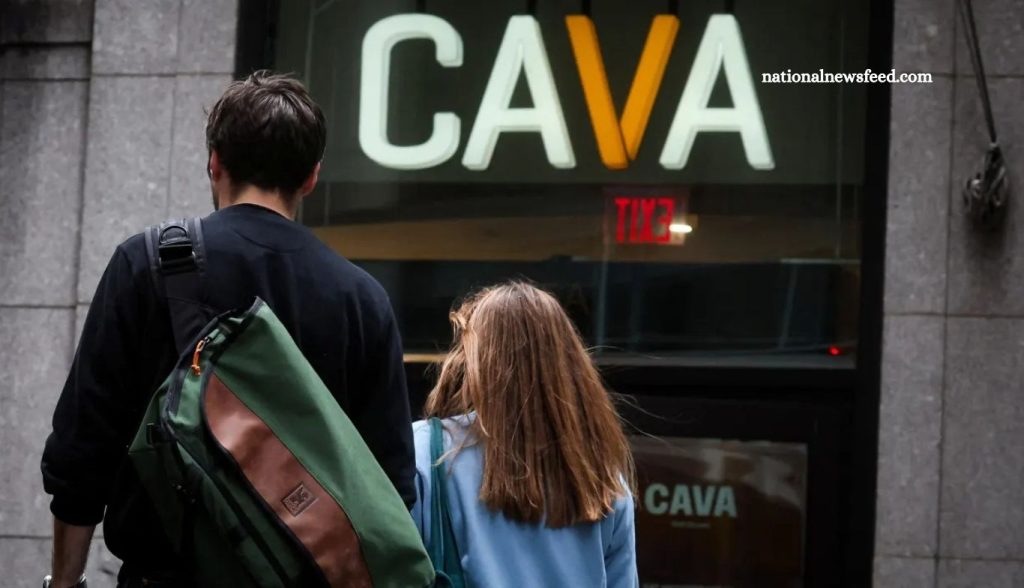Cava, the fast-casual Mediterranean chain, revised its full-year same-store sales growth forecast on Tuesday following a disappointing second quarter, sending its shares plummeting in after-hours trading. The company now expects same-store sales growth of 4% to 6% for the full year, down from its previous guidance of 6% to 8%.
The news contributed to a more than 20% decline in Cava’s stock during extended trading, marking a 40% drop in the stock’s value year-to-date, including the after-hours move.
Read More: Ford Commits $2 Billion to Louisville Plant to Produce Affordable Electric Vehicles
Second-Quarter Performance Highlights
Cava reported second-quarter earnings per share (EPS) of 16 cents, surpassing analysts’ expectations of 13 cents. Revenue totaled $280.6 million, slightly below the $285.6 million forecasted by Wall Street, based on LSEG analyst estimates.
Net income for the quarter came in at $18.4 million, or 16 cents per share, down from $19.7 million, or 17 cents per share, a year earlier. While net restaurant sales climbed 20% to $278.2 million, largely driven by new restaurant openings, same-store sales—which track locations operating for at least a year—only grew 2.1%.
Despite positive growth in same-store sales, Cava fell short of Wall Street’s 6.1% projection, according to StreetAccount data.
Traffic and Menu Impact
The company described quarterly traffic as “roughly flat.” This marks a significant slowdown compared with the prior year, when same-store sales rose 14.4%, supported by nearly double-digit traffic growth. Cava CEO and co-founder Brett Schulman attributed the strong prior-year performance to the introduction of the grilled steak option, which attracted repeat customers.
CFO Tricia Tolivar told CNBC that strong early-quarter same-store sales had initially reinforced the company’s previous forecast. However, after celebrating the one-year anniversary of the grilled steak launch, growth momentum slowed, leading to the downward revision.
Industry-Wide Challenges
Cava’s results mirror broader challenges in the fast-casual dining sector. Rival chains have also struggled with declining traffic and same-store sales. Chipotle Mexican Grill reported a 4% decline in same-store sales, while salad-focused Sweetgreen saw its stock tumble after reducing its outlook for the second consecutive quarter.
Despite these headwinds, Cava’s performance still outpaced many competitors, as the company avoided the same-store sales declines that affected others in the sector.
Financial Outlook and Strategic Initiatives
While reducing its same-store sales forecast, Cava reaffirmed other key financial targets for the year. Adjusted earnings before interest, taxes, depreciation, and amortization (EBITDA) are expected to range between $152 million and $159 million. The company also maintained its guidance for restaurant-level profit margins of 24.8% to 25.2%.
Cava is also investing in operational efficiency. On Tuesday, the company announced participation in a $25 million Series B funding round for Hyphen, a technology platform that automates plate and bowl portioning. The round was led by Chipotle, a previous investor in Hyphen.
Schulman highlighted the operational benefits of the technology, stating, “By piloting Hyphen’s automated digital makeline, we have the opportunity to increase order accuracy and speed during peak digital hours, while reducing complexity for our team members.” This move aligns with Cava’s broader strategy to streamline kitchen operations and enhance the customer experience amid a challenging sales environment.
Frequently Asked Questions
Why did Cava’s shares drop recently?
Cava’s stock fell sharply after the company lowered its full-year same-store sales growth forecast to 4%–6%, down from a prior range of 6%–8%. The downward revision came after weaker-than-expected second-quarter performance.
How did Cava perform in the second quarter?
Cava reported net income of $18.4 million, or 16 cents per share, slightly lower than the prior year’s $19.7 million, or 17 cents per share. Revenue totaled $280.6 million, just below Wall Street expectations of $285.6 million. Same-store sales grew 2.1%, falling short of analyst projections of 6.1%.
What are same-store sales and why do they matter?
Same-store sales measure revenue from restaurants open at least a year, providing insight into the performance of established locations. Investors use this metric to gauge customer traffic, menu popularity, and overall brand growth.
How does Cava’s performance compare to competitors?
While Cava saw modest same-store sales growth, other fast-casual chains faced declines. For example, Chipotle Mexican Grill reported a 4% decline, and Sweetgreen reduced its forecast for the second consecutive quarter.
What factors contributed to Cava’s slower sales growth?
Cava experienced flat customer traffic during the second quarter. While menu innovation, such as the grilled steak launch, previously drove higher traffic, the growth momentum slowed after its one-year anniversary.
Is Cava maintaining other financial targets?
Yes. The company reiterated its full-year adjusted EBITDA forecast of $152 million–$159 million and maintained expected restaurant-level profit margins of 24.8%–25.2%.
How is Cava investing in technology?
Cava participated in a $25 million Series B funding round for Hyphen, a platform that automates plate and bowl portioning. The technology aims to improve order accuracy, speed, and operational efficiency during peak hours.
Conclusion
Cava’s downward revision of its same-store sales forecast highlights the challenges facing the fast-casual restaurant sector, including slowing traffic and softer-than-expected sales growth. While new restaurant openings continue to drive revenue, flat customer visits and modest same-store sales gains have prompted a more cautious outlook.
Despite these short-term setbacks, Cava remains strategically positioned for long-term growth. Investments in menu innovation, such as the grilled steak offering, and technology solutions like Hyphen’s automated makeline, aim to enhance operational efficiency, improve order accuracy, and elevate the customer experience.

